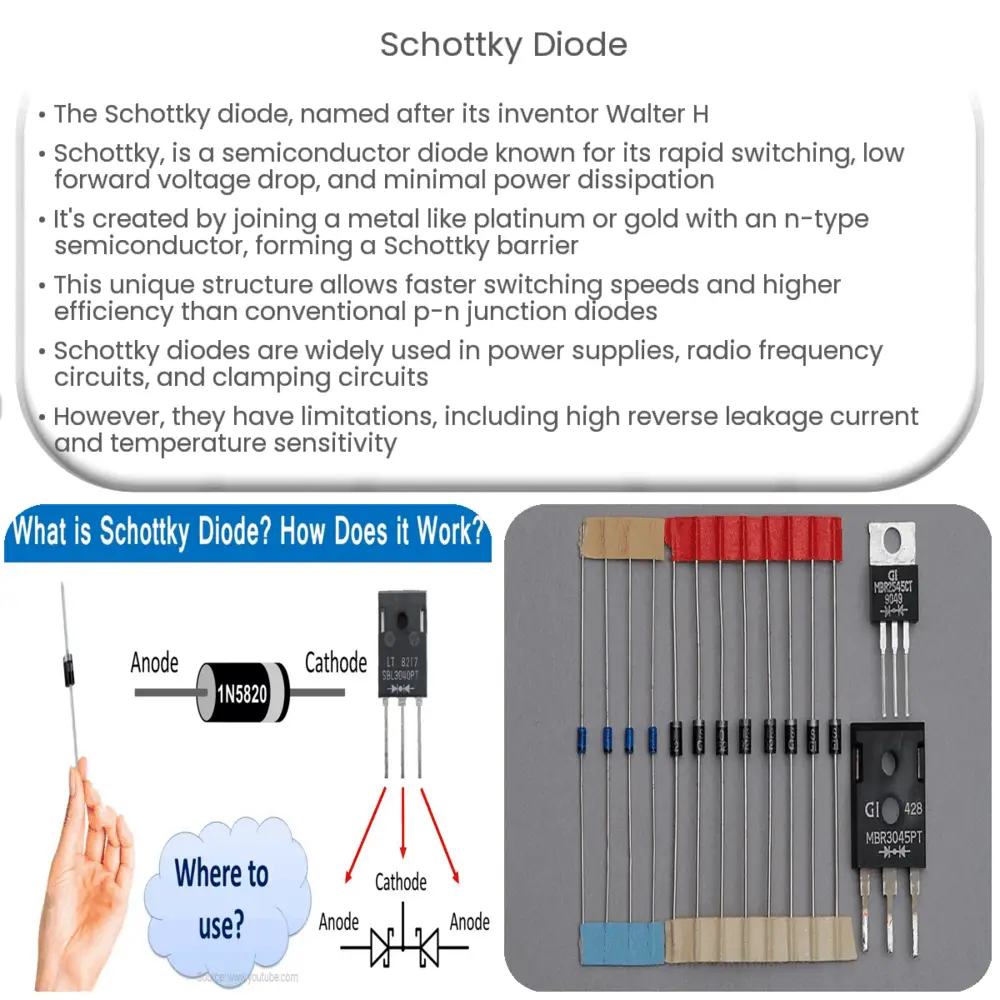Schottky diodes are fast-switching, low forward voltage semiconductors used in rectifiers, regulators, RF circuits, and clamping.

Schottky Diode: Introduction and Applications
A Schottky diode, also known as a hot carrier diode or Schottky barrier diode, is a type of semiconductor diode characterized by its fast switching capabilities, low forward voltage drop, and low power dissipation. Named after its inventor, German physicist Walter H. Schottky, the diode has found a wide range of applications in electronics, particularly in high-frequency and power circuits.
Construction and Principle of Operation
A Schottky diode is formed by the junction of a metal, typically a metal such as platinum, gold, or tungsten, with an n-type semiconductor like silicon or gallium arsenide. The interface between the metal and semiconductor forms a Schottky barrier, which is a potential barrier that prevents charge carriers from crossing the junction. When a voltage is applied to the diode, the charge carriers (electrons) can overcome this barrier, resulting in current flow.
Compared to conventional p-n junction diodes, Schottky diodes exhibit a lower forward voltage drop (typically around 0.15 to 0.45 volts) and faster switching speeds due to their unique construction. The absence of a p-type semiconductor eliminates the need for charge carriers to recombine, resulting in reduced power dissipation and improved efficiency.
Applications of Schottky Diodes
Schottky diodes have a variety of applications in electronics, including:
- Rectifiers: Schottky diodes are often used in power supply circuits as rectifiers, converting alternating current (AC) to direct current (DC). Their low forward voltage drop and fast switching capabilities make them ideal for this purpose, as they result in less power loss and higher efficiency compared to traditional rectifiers.
- Switching regulators: Due to their fast switching speeds, Schottky diodes are commonly used in switching regulator circuits, where they enable the rapid regulation of output voltage. These regulators are typically found in power supplies, battery chargers, and DC-to-DC converters.
- Clamping circuits: Schottky diodes can be used to protect sensitive electronic components from voltage spikes by clamping the voltage to a safe level. In these applications, the diode’s low forward voltage drop and fast response time are key factors in its effectiveness.
- Radio frequency (RF) circuits: The fast switching speeds of Schottky diodes make them ideal for use in RF circuits, such as mixers, detectors, and frequency multipliers. They enable the efficient conversion of RF signals while maintaining high signal integrity.
In the next section, we will explore the advantages and disadvantages of Schottky diodes, as well as the factors that influence their performance.
Advantages and Disadvantages of Schottky Diodes
Like all electronic components, Schottky diodes have their own set of advantages and disadvantages. Some of the key benefits and drawbacks include:
Advantages
- Low forward voltage drop: Schottky diodes have a lower forward voltage drop compared to traditional p-n junction diodes, resulting in less power loss and higher efficiency.
- Fast switching speeds: The absence of a p-type semiconductor allows Schottky diodes to switch rapidly between conducting and non-conducting states, making them suitable for high-frequency applications.
- Low reverse recovery time: Unlike conventional diodes, Schottky diodes have no charge storage, which means that they have a negligible reverse recovery time. This feature is particularly beneficial in high-speed switching applications.
Disadvantages
- High reverse leakage current: Schottky diodes have a higher reverse leakage current than traditional p-n junction diodes, which can lead to increased power dissipation and reduced efficiency under certain conditions.
- Lower reverse voltage rating: Schottky diodes generally have lower reverse voltage ratings compared to conventional diodes, which can limit their use in high-voltage applications.
- Temperature sensitivity: The performance of Schottky diodes is more sensitive to temperature changes compared to conventional diodes. As temperature increases, the reverse leakage current and forward voltage drop can both increase, affecting the overall efficiency of the diode.
Factors Influencing Schottky Diode Performance
Several factors can influence the performance of a Schottky diode, including:
- Metal-semiconductor combination: The choice of metal and semiconductor materials used in the construction of the Schottky diode can significantly affect its characteristics, such as the forward voltage drop, reverse leakage current, and barrier height.
- Temperature: As mentioned earlier, Schottky diode performance is temperature-sensitive. The forward voltage drop, reverse leakage current, and barrier height can all be affected by changes in temperature.
- Device geometry: The size and shape of the Schottky junction can impact the diode’s characteristics, such as its current-carrying capacity and breakdown voltage. Smaller junctions generally have higher breakdown voltages but lower current-carrying capacities.
In conclusion, Schottky diodes are an essential component in modern electronics due to their fast switching speeds, low forward voltage drop, and low power dissipation. However, it is crucial to consider their limitations, such as high reverse leakage current and temperature sensitivity, when designing circuits that incorporate Schottky diodes. By understanding the factors that influence their performance, engineers can select the appropriate diode for a given application and optimize its performance.

